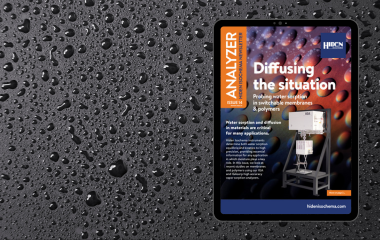Understanding Key Techniques for Nanoporous Materials Characterisation
Nanoporous materials, such as activated carbons, zeolites, metal-organic frameworks (MOFs), and mesoporous silicas, play a vital role in a variety of applications due to their high surface area and porosity. The ability to provide accurate nanoporous materials characterisation is crucial for understanding the materials’ properties and enhancing their performance. Here, we explore some of the key characterisation techniques used with nanoporous materials.
Gas Adsorption Analysis
Gas adsorption analysis is a fundamental technique for characterising nanoporous materials. This method, particularly nitrogen adsorption at 77K, is extensively used to determine:
- Surface area
- Pore volume
- Pore size distribution.
Here, the process involves measuring the adsorption isotherm. This depicts the amount of gas adsorbed as a function of pressure at a constant temperature.
Surface Area Determination
The Brunauer-Emmett-Teller (BET) theory is commonly applied to calculate the surface area from the adsorption isotherm. The BET method assumes that gas molecules form a monolayer on the surface of the material, followed by multilayer adsorption. By analysing the linear region of the BET plot, the specific surface area can be accurately determined.
Pore Size Distribution
To evaluate the pore size distribution, the Barrett-Joyner-Halenda (BJH) method is frequently employed. This approach is based on the capillary condensation of the adsorbate in the pores and the corresponding desorption isotherm. The BJH method provides detailed insights into the mesoporous and macroporous structures of the material, crucial for applications in catalysis and separation processes.
High Pressure Gas Adsorption
As well as routine surface area and porosity measurements at pressures up to 1 bar, high pressure gas sorption measurements are used to study the ability of a material to store, or separate gas species at higher pressures. Isotherm measurements can yield both the thermodynamics and kinetics of adsorption and desorption processes. These are essential for optimizing the material’s performance in applications like gas storage and separation.
Dynamic Vapor Sorption (DVS)
Dynamic Vapor Sorption (DVS) is a gravimetric technique that measures the weight change of a sample as it adsorbs or desorbs vapors such as water, organic solvents at controlled temperatures and vapor pressures. This technique provides quantitative data on moisture interaction, sorption kinetics, and diffusion coefficients.
Moisture Interaction and Stability
Understanding how nanoporous materials interact with moisture is essential for assessing their stability and performance in various environments. DVS can accurately quantify the amount of moisture nanoporous materials can adsorb and how quickly it reaches equilibrium. This information is critical for applications where moisture sensitivity and stability are crucial, including in drug delivery and storage.
Sorption Kinetics and Diffusion
DVS also offers insights into the sorption kinetics and diffusion behavior of vapors within the material. By analysing the rate of weight change over time, researchers can determine the diffusion coefficients.
Breakthrough Curve Analysis
Breakthrough curve analysis is a technique used to evaluate the adsorption capacity, selectivity, and kinetics of nanoporous materials for various gases. This method involves passing a gas stream through a packed bed of the material. From there, the outlet concentration is monitored over time.
Adsorption Capacity and Selectivity
The breakthrough curve provides valuable information about the adsorption capacity of the material for a specific gas. The point at which the gas begins to appear at the outlet indicates the breakthrough time, which is directly related to the adsorption capacity. Additionally, by using gas mixtures, the selectivity of the material for different gases can be determined. This is essential for applications in gas separation and purification.
Kinetics of Adsorption
Breakthrough curve analysis also allows for the study of adsorption kinetics. The shape of the curve can reveal details about the rate of adsorption and the potential presence of mass transfer limitations within the material. This information is crucial for designing efficient adsorption processes and optimizing material performance.
Gravimetric Sorption Analyzers
Gravimetric sorption analyzers, such as our Intelligent Gravimetric Analyzers (IGAs) the IGA-001 and IGA-002, are specialized instruments designed to precisely measure the weight change of a sample during gas or vapor adsorption and desorption.
High Accuracy and Pressure Regulation
These analyzers offer high accuracy and active pressure regulation, ensuring reliable and reproducible measurements. The ability to control the pressure precisely is vital for studying the adsorption behavior under different conditions, enabling comprehensive characterisation of nanoporous materials.
Advanced Kinetic Analysis
Gravimetric sorption analyzers also provide advanced kinetic analysis capabilities, allowing researchers to study the dynamics of adsorption and desorption processes in detail. This information is invaluable for understanding the mechanisms of gas uptake and release, which is critical for applications in energy storage, catalysis, and environmental remediation.
These techniques provide complementary information about the structural and adsorptive properties of nanoporous materials. They enable researchers and industries to optimize the performance of nanoporous materials in various applications, such as gas storage, separations, catalysis, and drug delivery.
Nanoporous Materials Characterisation Equipment is Available at Hiden Isochema
We, Hiden Isochema, offer a comprehensive range of products and solutions for the characterisation of nanoporous materials, as well as many other types of materials. Our state-of-the-art instruments and advanced analytical techniques ensure accurate and reliable data, empowering researchers to achieve breakthroughs in material science and engineering.


